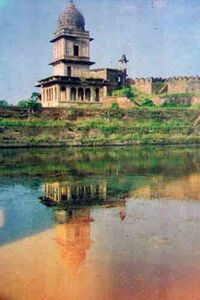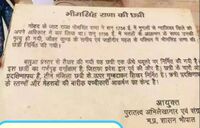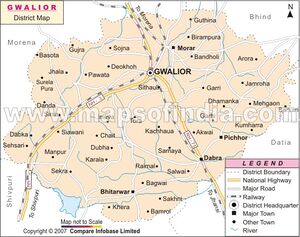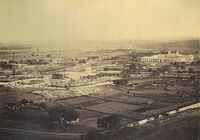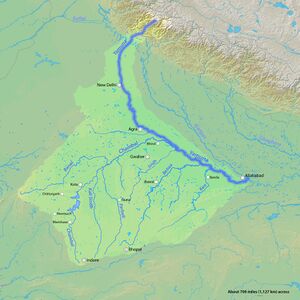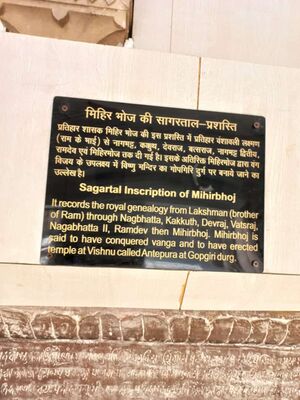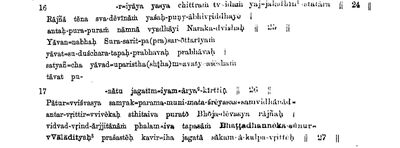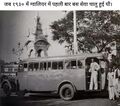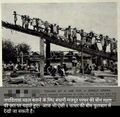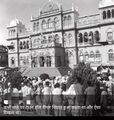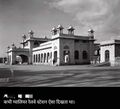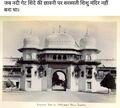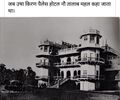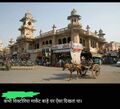Gwalior
| Author:Laxman Burdak, IFS (R) |
Gwalior (ग्वालियर) is a city in Madhya Pradesh in India.
Location
It lies 76 miles (122 km) south of Agra and has a population of over 12 lakh (1,200,000). The Gwalior metropolitan area is the 46th most populated area in the country.
Gwalior occupies a strategic location in the Gird region of North India, and the city and its fortress have served as the center of several of North India's historic kingdoms. At present also its strategic location is marked by the presence of major air base at Maharajpura. Gwalior is the administrative headquarters of Gwalior district and Gwalior division.
Variants of name
- Gopachal/ Gopachala/Gopāchala (गोपाचल) (AS, p.281), (AS, p.300)
- Gopadri (गोपाद्रि) (AS, p.281), (AS, p.300)
- Gopanchal (गोपांचल)
- Gopagiri (गोपगिरि) (AS, p.281)
- Gopasetra
- Gwalagiri (ग्वालगिरि)
- Gopalakaccha (गॊपालकच्छ) Mahabharata (II.27.3), (VI.10.55)
- Gopalakaksha (गोपालकक्ष) (AS, p.281)
Geography
Gwalior is located at 26.22|N|78.18|E [1]. It has an average elevation of 197 metres. Gwalior is a historical Indian city - is located on the periphery of Madhya Pradesh State, 321 km (199.5 Miles) from Delhi and 121 km (76 Miles) from Agra.
Tahsils in Gwalior District
1. Bhitarwar 2. Chinour 3. Dabra 4.Gird (Gwalior) 5.Ghatigaon 6.Tansen 7..Murar 8. City Center
Villages in Gwalior tahsil
1. Adupura Khalsa, 2. Adupurajagir, 3. Agrabhatpura, 4. Ajaypur, 5. Akbarpur, 6. Alinagar, 7. Amai, 8. Amargarh, 9. Antri, 10. Ari, 11. Aroli, 12. Aron, 13. Arora, 14. Arroli, 15. Badagaon, 16. Badagaonjagir, 17. Baderafutkar, 18. Badkagaon , 19. Badori, 20. Bagwalagaon, 21. Bahadurpur, 22. Bahangikalan, 23. Bahangikhurd, 24. Banarpura, 25. Bandha, 26. Bandholi, 27. Banhera, 28. Banheri, 29. Barahana, 30. Barai, 31. Baraipura, 32. Baraj Kalan, 33. Baraua Nurabad, 34. Barauapichhore, 35. Baretha, 36. Basota, 37. Bastari, 38. Behat, 39. Behata, 40. Bela, 41. Benipura, 42. Berja, 43. Berkheda, 44. Bhadroli, 45. Bhagwan Ka Pura, 46. Bhakarra, 47. Bhatpura, 48. Bhatpura Sani, 49. Bhavanpura, 50. Bhaypura, 51. Bhelakalan, 52. Bhelakhurd, 53. Bhonderi, 54. Bhoreshwar, 55. Bijoli, 56. Bilara, 57. Bilheti, 58. Bilpura, 59. Birampura, 60. Bithauli, 61. Cakjugrupur, 62. Cakrampur, 63. Chait, 64. Chak Girvai No 1, 65. Chak Keshopur, 66. Chakmaharajpur, 67. Chaksonpura, 68. Chandoha Khurd, 69. Chandpura, 70. Chandupura, 71. Changora, 72. Chaproli, 73. Charaidang, 74. Charaipilkhana, 75. Charairehanta, 76. Charaisikrawali, 77. Chhapra, 78. Chhikari, 79. Chhonda, 80. Chhondi, 81. Chui, 82. Dabka, 83. Dadori, 84. Dagrau, 85. Dain, 86. Dangguthina, 87. Dangiyapura, 88. Dangkandhar, 89. Dangora, 90. Dangsarkar, 91. Dayeli, 92. Dhaneli, 93. Dhanwai, 94. Dharamgarh, 95. Dhuwan, 96. Domtorkhalsa, 97. Domtormafi, 98. Dondiyapur, 99. Dongarpur Tal , 100. Dorar, 101. Dugnawali , 102. Duhiya, 103. Dundapura, 104. Durgasi, 105. Dursedi, 106. Dwarkaganj, 107. Fusawali, 108. Gadroli, 109. Gajipura, 110. Ganeshpura, 111. Gangapur, 112. Ganpatpura, 113. Ghatigaon, 114. Ghatwasini, 115. Ghegholi, 116. Ghusgawan, 117. Girgaw, 118. Girvai, 119. Gowai, 120. Gundhara, 121. Gunjna, 122. Gurja, 123. Gurri, 124. Guthina, 125. Habipura, 126. Harjanpura, 127. Harpura, 128. Hastanapur, 129. Himapura, 130. Hiri, 131. Hukamgarh, 132. Ikehara, 133. Ikona, 134. Imliya 135. Jadidrai, 136. Jagupura, 137. Jahangirpur, 138. Jakha, 139. Jakhara Gwalior, 140. Jakhoda, 141. Jakhodi, 142. Jamahar, 143. Jamroha, 144. Jarga, 145. Jebra, 146. Jiganiya, 147. Jigsoli, 148. Jinawali, 149. Jindpura, 150. Jinsikhan, 151. Jiraina, 152. Jivajipur, 153. Jlalpur, 154. Jugrupur, 155. Kaimpura, 156. Kaitha, 157. Kakrari, 158. Kalawah, 159. Kalyanpur, 160. Karahi Karai, 161. Karigawan, 162. Kemari, 163. Keriya Pdyapur, 164. Keroli , 165. Khargu Kheda, 166. Kheda, 167. Khedi, 168. Kheriya Bhat, 169. Kheriya Kachhai, 170. Kheriya Keshar, 171. Kheriya Kuleth , 172. Kheriya Mirdha, 173. Kheriya Modi, 174. Kheriya Mritya, 175. Khitera, 176. Khodupura, 177. Khudawali, 178. Khureri, 179. Kiat, 180. Kirawali, 181. Kotaviran, 182. Kripalpur, 183. Kui, 184. Kuleth, 185. Kushrajpur, 186. Kuwrpur, 187. Laduapura, 188. Lakhanpura, 189. Lakhapura, 190. Lakhnotikalan, 191. Lakhnotikhurd, 192. Laxmangarh, 193. Londra, 194. Luharpura, 195. Madanpur, 196. Madha, 197. Maharajpura, 198. Maharampura, 199. Maheshwara, 200. Mahua Kheda, 201. Maithana, 202. Malipura, 203. Malnpur, 204. Mangupura, 205. Manpur, 206. Manpur Arroli, 207. Manpur Kakrari, 208. Mau, 209. Mehadpur, 210. Mehroli, 211. Milawali, 212. Mircha, 213. Mohana, 214. Mohanpur, 215. Mohnpur, 216. Mugalpura, 217. Mukhtyarpur, 218. Nagdha, 219. Nagor, 220. Nainagiri, 221. Narayanpur, 222. Naugaon, 223. Nayagaon, 224. Nayakpura, 225. Nidhawali, 226. Nirawali, 227. Nonera, 228. Obra, 229. Odpura, 230. Pahi Aron, 231. Panihar, 232. Par, 233. Para, 234. Parpate Ka Pura, 235. Parsen, 236. Patai, 237. Patpari, 238. Pawa Madaiya, 239. Pawata, 240. Pehasari Pehsari, 241. Phoolpura, 242. Piproli, 243. Poonchhari, 244. Prayagpura, 245. Puranichavni, 246. Purasani, 247. Rahwali, 248. Rai, 249. Raikasba, 250. Raipur, 251. Rairu, 252. Ramaua, 253. Rampur, 254. Rampura, 255. Rangawan, 256. Rashidpur, 257. Ratwai, 258. Rawar, 259. Renhat, 260. Renhati Rehati81, 261. Ripuapura, 262. Roodhpura, 263. Rora, 264. Sahasari, 265. vSahnpur, 266. Sakatpura, 267. Salupura, 268. Samedi, 269. Samrai, 270. Sankua, 271. Santalpur, 272. Santau, 273. Saraspura , 274. Seedhni, 275. Sekra, 276. Sekri, 277. Senthri, 278. Shambhupur, 279. Shankrpur, 280. Shekhpura, 281. Shyampur, 282. Sigora, 283. Sihara, 284. Siholi, 285. Sikrawali, 286. Sikroda Badori, 287. Sikroda Futkar, 288. Sikrodi, 289. Simiriya Tanka, 290. Singharpura, 291. Singhpur, 292. Sirol, 293. Siroli, 294. Sirsa, 295. Sirsaud, 296. Siyawari, 297. Sojna, 298. Sonapura, 299. Soni, 300. Sonsa, 301. Sujhar, 302. Sujway, 303. Sumawali, 304. Sumerpada, 305. Sunarpura Khalsa, 306. Sunarpura Mafi, 307. Supat, 308. Supawali, 309. Surajpura, 310. Surhela, 311. Suro, 312. Susera, 313. Syawari, 314. Tadhai, 315. Talpura, 316. Tankoli, 317. Tehlri, 318. Thar, 319. Tighra, 320. Tiholi, 321. [[Tiktoli, 322. Tilawali, 323. Tiletha, 324. Tilghana, 325. Tor, 326. Turakpura, 327. Turari, 328. Udaipur, 329. Ummedgarh , 330. Utila, 331. Vikrampur, 332. Virpur,
Origin of name
The city is named after a sage called Gwaliap. A king once met this sage in a dense forest, and the sage told him to build a city on that spot after his name.
Jatwara Trans Chambal
The approximate axis of the Jatwara Trans Chambal could be taken to comprise the general line represented by Bhind, Gohad and Indargarh, overlapping the modern districts of Bhind (Gohad and Lahar tahsils), Gwalior (Morar and Bhitarwar blocks and Dabra tahsils) and Datia (Indargarh tahsil) in the present day Madhya Pradesh. Astride this axis and in a fan-like direction from it, there is a scattered population of Jats: to the East, it extends towards the lower reaches of the Chambal and Sind Rivers: to the West towards Gwalior, Shivpuri, Dabra, Magrora, and Bhitarwar. Gohad, Pichhore and Magrora were Jat states having about 360 Jat Forts. As a rule exclusive Jat habitations are few. More often the Jat is to be found in solitary homesteads in composite ethnic villages, his remote ancestor probably having been assigned the custody of the local Jat garhi (minor fortification), still precariously perched atop the neighboring hillock.
Jat Gotras in and around Gwalior
- Agre,
- Antil,
- Aulakh,
- Badak,
- Badgoti,
- Badsera,
- Bamraulia,
- Baswan,
- Beniwal,
- Beta,
- Bhadhotia,
- Bhagor,
- Bharangar,
- Bohra,
- Chahar,
- Cheema,
- Chima,
- Dagur,
- Dandak,
- Dahiya,
- Dhillon,
- Donderia,
- Duhun,
- Ghadaria,
- Gill,
- Gollia,
- Govalia,
- Hindol,
- Jadu,
- Jakhar,
- Jatri
- Kadyan,
- Kadayan,
- Kaharwar,
- Kahirwar,
- Karelia,
- Kayjan,
- Khatepar,
- Khirwar,
- Koyal,
- Kundu,
- Lamba,
- Langur,
- Lekhpuria,
- Lohchab,
- Maan,
- Malik,
- Nain,
- Nohwar,
- Pachar,
- Pahalwar,
- Pachehara,
- Panchal,
- Panni,
- Pannu,
- Paraswal,
- Pawar,
- Pilania,
- Ponia,
- Poonia,
- Rajora,
- Rana,
- Rawat,
- Retwar,
- Ronkha,
- Roria,
- Ruhal,
- Sehrawat,
- Sadele,
- Shyoran,
- Siddhu,
- Sikarwar,
- Singhal,
- Sinsinwar,
- Sirohi,
- Siwach,
- Sogaria,
- Sohrawal,
- Sonhrot,
- Solanki,
- Sovarwar,
- Soora,
- Talan,
- Tangar,
- Tawar Dagur,
- Tewatia,
- Thakurela,
- Thenua,
- Tikaria,
- Tomar,
- Ujalayan,
History
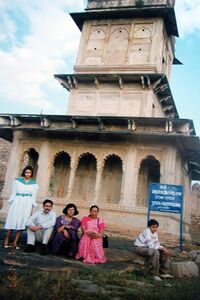
Ram Sarup Joon[2] writes that ....Samudra Gupta conquered the whole of Punjab and a major part of India. The clans defeated by him included
- Malaya who ruled Malva named after their gotra.
- Arjunayana who ruled Mewat and Jaipur;
- Yaudheya whose rule included Bikaner and Bahawalpur;
- Madrak whose capital was Sialkot;
- Abir who ruled Badaun, and the Betwa Basin now called Ahirwara;
- Vir Arjun clan who ruled Narisinghpur;
- Sankanika who territory was present Gwalior;
- Karaskar rule extended into present Mathura, Aligarh (there are 80 villages of these Jats in this area at present) and Kharparika.
Ram Sarup Joon[3] writes that ...The Pehwa edict describes the rule of three Pratihar kings. It is mentioned that they were the descendants of 'Jabala', the Hun who had ruled there before them- the third edict narrates the rule of Jabla Toraman.
There is an old saying in Rohilkhand that the Chief Toraman Kachwaha attacked Iran in 943 A.D. He conquered the territory from Iran to Bhopal. He constructed a fort at Gwalior. The descendants of Bhur Sen came to be called Kachhwaha in 945 A.D., and ruled Gwalior till 933 A.D., when Pratihars seized power. Therefore, if we accept this the Kachwaha Rajputs are the descendants of Torman, Jabla Gujars.
Charak Rai (the Bhat] who lived during the reign of Emperor Shah Jehan writes that the king of Iran was Torman. Shri Bhanderkar and General Cunningham and Mr. Smith all prove that Torman, Kachwaha and Pratihars are all descendants of Jabla Gujars. One of the edicts of Hun Chief Jabla was excavated in Malwa, at Mandsor, and is said to have been inscribed in 533 A.D.
According to this edict King Meharkul was the son of Torman, who was defeated and driven out by Yashodharaman.
Ram Sarup Joon[4] writes that ...In the history of Bundel Khand Mr. Bage Bahadur Mazbut S1ngh has elaborated, proving Gwalior Pratihars as Gujars. An elder of King Brijman Pratihar Laxman was on the throne of Gwalior in 933 AD, According to Shri Bhanderkar, after Brijman, the Pratihar kings adopted the title of Kachwaha. From the foregoing it is quite evident that Pratihars and Kachwahas are of the same stock.
At the heart of Gwalior is its fortress (Gwalior Fort), built by Raja Man Singh Tomar, of the Tomar dynasty. This formidable structure had the reputation of being one of the most invincible forts of India. It occupies an isolated rock outcrop. The hill is steepended to make it virtually unscalable and is surrounded by high walls which enclose buildings from several periods. The old town of Gwalior lies at the eastern base of the fortress. Lashkar, formerly a separate town that originated as a military camp, lies to the south, and Morar, also a formerly separate town, lies to the east . Gwalior, Lashkar and Morar are presently part of Gwalior Municipality.
Massive Gwalior Fort, popularly called Gibraltar of India overlooks the city. The great Mughal Emperor Babur reputedly described it as, "The pearl in the necklace of the forts of Hind".
In the east of the city are two magnificent examples of early Mughal architecture. One is mausoleum of, 16th century Sufi saint Ghous Mohammed, and another is tomb of Mian Tansen, a great singer and one of the 'Nine Jewels' of Emperor Akbar's court.
Close to the heart of the city is splendid Jai Vilas Palace, patterned on the style of the 'Palais de Versailles' in France combines Tuscan, Italian and Corinthian styles of architecture.
Rich in cultural heritage and architectural marvels, Gwalior has the added advantage of it's proximity to Agra, the city of Taj Mahal, Khajuraho, the city of great temples and Delhi, the national capital.
Historically and architecturally, Gwalior is interesting first as a very ancient seat of Jain worship; secondly for its example of palace architecture of the best Hindu period (1486-1516); and thirdly as an historic fortress. Many historical places are found near the Dabra-Bhitarwar Road. Prior to the founding of Gwalior the region was also known by its ancient name of Gopasetra. The great Apabhramsha poet Pandit Raighu lived in Gwalior. Gwalior had an institutional seat of the Bhattarakas of Kashtha Sangh and later Mula Sangh.
According to local legend, the original fort of Gwalior was founded by the Kachwaha chief, Suraj Sen. His palace is the most interesting example of early Hindu work of its class in India. Another palace of even greater extent was added to this in 1516. The Mughal emperors Jahangir and Shah Jahan added palaces to these two, the whole making a group of edifices unequalled for picturesqueness and interest by anything of their class in central India. Among the apartments in the palace was the celebrated chamber, named the Baradari, supported on 12 columns, and 45 ft (15 m) square, with a stone roof, forming one of the most beautiful palace-halls in the world. It was, besides, singularly interesting from the expedients to which the Hindu architect was forced to resort to imitate the vaults of the Muslims. Of the buildings, however, which so excited the admiration of the first Mughal emperor Babur, probably little now remains.
Jai Vilas palace, in Lashkar is a marvellous palace museum, part of which is open to the public and gives a glimpse into the life of the royal family.
The Fort area is also home of the Scindia School, a well regarded institution founded by the late Maratha Maharaja Madho Rao Scindia of Gwalior in 1897.
A striking part of the Jain remains at Gwalior is a series caves or rock-cut sculptures, excavated in the rock on all sides, and numbering nearly a hundred, great and small. Most of them are mere niches to contain statues, though some are cells that may have been originally intended for residences. One curious fact regarding them is that, according to inscriptions, they were all excavated within the short period of about thirty-three years, between 1441 and 1474. One of the colossal figures is 57 ft (17 m) high, which is taller than any other in northern India.
Gwalior fort also has the Gurudwara Data Bandi built in the memory of the sixth Sikh Guru Har Gobind. This Gurudwara is particularly large and grand, built entirely of marble with coloured glass decorating the main building. Recital of the Guru Granth Sahib creates a peaceful and sacred atmosphere.
Jat Monuments
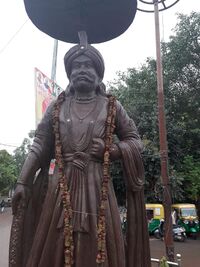
- Bhim Singh Rana Chhatri at Gwalior Fort
- Bhim Singh Rana Statue at Jail Road Circle Gwalior on Fort Road installed on 28 March 2015 (Jat Samaj, Agra, April 2015,p.32)
गोपाचल - गोपाद्रि- गोपालकक्ष
विजयेन्द्र कुमार माथुर[5] ने लेख किया है ...गोपालकक्ष (AS, p.300) नामक स्थान का उल्लेख महाभारत में हुआ है- 'ततो गोपालकक्ष च सोत्तरात्रपि कोसलान् मल्लानामधिपं चैव पार्थिवं चाजयत् प्रभु:।' महाभारत सभा. 30, 1. कुछ विद्वानों के मत में गोपालकक्ष ग्वालियर का ही प्राचीन नाम है। महाभारत 30, 3 में गोपालकक्ष नामक स्थान पर भीम की विजय का उल्लेख है। संभवतः यह गोपाद्रि और गोपाचल ग्वालियर दुर्ग की पहाड़ी के प्राचीन नाम हैं. (दे. ग्वालियर)
ग्वालियर
विजयेन्द्र कुमार माथुर[6] ने लेख किया है ...ग्वालियर (AS, p.281) प्राचीन नाम गोपाद्रि या गोपगिरि है। जनश्रुति है कि राजपूत नरेश सूरजसेन ने ग्वालिप नाम के साधु के कहने से यह नगर बसाया था। महाभारत सभापर्व 30,3 में गोपालकक्ष नामक स्थान पर भीम की विजय का उल्लेख है। संभवतः यह गोपाद्रि ही है।
[p.282]: ग्वालियर का दुर्ग बहुत प्राचीन है और इसका प्रारंभिक इतिहास तिमिराच्छन है. हूण महाराजाधिराज तोरमाण के पुत्र मिहिरकुल के शासनकाल के 15 वें वर्ष (525 ई.) का एक शिलालेख ग्वालियर दुर्ग से प्राप्त हुआ था जिसमें मातृचेत नामक व्यक्ति द्वारा गोपाद्रि या गोप नाम की पहाड़ी (जिस पर दुर्ग स्थित है) पर एक सूर्य मंदिर बनवाए जाने का उल्लेख है. इससे स्पष्ट है कि इस पहाड़ी का प्राचीन नाम गोपाद्रि (रूपांतर गोपाचल, गोपगिरि) है तथा इस पर किसी न किसी प्रकार की बस्ती गुप्त काल में भी थी.
इतिहास से सूचित होता है कि ग्वालियर में 875 ई. में कन्नौज के गुर्जर प्रतिहारों का राज्य था. मुसलमानों के आक्रमण के समय भी यहां कछवाहा, प्रतिहार आदि राजपूत वंश राज्य करते थे. 1232 ई. में दिल्ली के गुलाम वंश के सुल्तान इल्तुतमिश ने ग्वालियर के किले को हस्तगत किया और राजपूत रानियों ने जोहर की प्रथा के अनुसार अग्नि में कूद कर प्राण त्याग दिए.
1399 से 1516 ई. तक यह किला तोमर नरेशों के अधीन रहा जिनमें प्रमुख मानसिंह था. इसकी रानी गूजरी या मृगनैनी के विषय में अनेक किंवदंतियां प्रचलित हैं. किले का गूजरी महल मृगनयनी का ही अमिट स्मारक है. 1528 ई. में बाबर ने यह किला जीता. मुगलों ने इसका उपयोग एक सुदृढ़ कारागार के रूप में किया. इसमें राजनीतिक बंदी रखे जाते थे. औरंगजेब ने अपने भाई और गद्दी के हकदार मुराद और तत्पश्चात दारा के पुत्र सुलेमानशिकोह को कैद करके इसी किले में बंद रखा. मुगलों के अपकर्ष के समय जब महाराष्ट्र के प्रमुख सरदार सिंधिया का दिल्ली-आगरा के पार्श्ववर्ती प्रदेश में आधिपत्य स्थापित हुआ तो उसी समय ग्वालियर भी उसके हाथ में आ गया. इस प्रकार वर्तमान काल तक सिंधिया के राज्य की राजधानी ग्वालियर में ही रही. दुर्ग के स्मारकों में ग्वालियर का लंबा इतिहास प्रतिबिंबित होता है. यहां का सर्व प्राचीन स्मारक मातृचेत का बनवाया हुआ सूर्य मंदिर ही था जिसका कोई चिन्ह अब नहीं है किंतु जिसकी स्थिति सूरज तालाब के निकट रही होगी. दूसरा स्मारक चतुर्भुज विष्णु का मंदिर है जो पहाड़ी के पार्श्व में काटा गया है.
इसमें एक चौकोर देवालय के ऊपर एक शिखर है और पूर्व मध्यकालीन शैली में बना हुआ सभामंडप. इस मंदिर को 875 ई. अल्ल नामक व्यक्ति ने गुर्जर प्रतिहार नरेश रामदेव के समय में बनवाया था. इसके पश्चात 1093 ई. में बना हुआ सास-बहू (सहस्त्रबाहु ?) का मंदिर ग्वालियर-दुर्ग का एक विशेष ऐतिहासिक स्मारक है. इसे कछवाहा नरेश महिपाल में निर्मित किया था. यह भी विष्णु का मंदिर है. कहा
[283]: जाता है कि पहले इसका शिखर 100 फुट ऊंचा था. अब इसका गर्भगृह तथा शिखर दोनों ही संरचनाएं विनष्ट हो गई हैं किंतु इसकी कला का वैभव, सभामंडप की छत की अद्भुत नक्काशी और मंदिर के बाहरी और भीतरी भागों पर निर्मित विशद मूर्तिकारी से प्रकट होता है. इसी प्रकार मंदिर के द्वारों के सिरदलों की सूक्ष्म तथा प्रभावोत्पादक मूर्तिकारी भी परम प्रशंसनीय है. द्वार की पत्थर की चौखटों पर गंगा-यमुना की मूर्तियां और पुष्पालंकरण खचित हैं जो गुप्तकालीन परंपरा में हैं. सभामंडप की छत पर भी कीर्तिमुखों के सहित पुष्पालंकरणों का अंकन बड़ी विदग्घता और सुंदरता के साथ किया गया है. सास-बहू मंदिर से कुछ दूर पर दुर्ग का सर्वोच्च स्मारक 'तेली का मंदिर' स्थित है.
इसकी ऊंचाई 100 फुट से भी अधिक है. इसकी शिखर की विशेषता इसकी द्रविड़ शैली है. इसका निर्माण काल आठवीं सदी से लेकर 10वीं सदी तक माना जाता है. इस मंदिर के ऊपर की नक्काशी सास-बहू के मंदिर के नक्काशी की अपेक्षा सादी किंतु अधिक प्रभावशाली है. कालक्रम में इस मंदिर के पश्चात दुर्ग की पहाड़ी में चारों ओर उत्कीर्ण जैन तीर्थंकरों की विशाल नग्न मूर्तियां आती हैं जिनमें एक 57 फुट ऊँची है. ये सब 15वीं शती में बनी थी. 15 वीं सदी के तोमर राजाओं के जमाने के अन्य विख्यात स्मारक भी इस दुर्ग में हैं जिनमें मान-मंदिर और गूजरी-महल मुख्य हैं. मानमंदिर की ख्याती का कारण इसकी शुद्ध भारतीय या हिंदू वास्तु-शैली है. यह 300 फुट ऊंची पहाड़ी की चोटी पर बना हुआ है. इस विस्तृत भवन पर छ: वर्तुल छतरियां बनी हैं. 1528 ई. में जब बाबर ने ग्वालियर का किला देखा था तब इन छतरियों पर सुनहरी काम था जिससे ये दूर से सूर्य के प्रकाश में चमकती थी. इस भवन के पूर्वाभिमुख भाग से बीहड़ पहाड़ी प्रदेश की मनोरम झांकी मिलती है. इसके अंदर मानसिंह का प्रासाद है जिसकी वास्तुशैली सर्वथा भारतीय है. इस शैली का प्रभाव अकबर की फतेहपुर-सीकरी के भवनों में देखा जा सकता है. गूजरी-महल दुमंजिला भवन है जिसका बाहरी भाग सादा और भव्य है. इस पर गुंबद बने हैं और अंदर एक प्रांगण के चारों ओर प्रकोष्ठों की पंक्ति है.
दुर्ग के अन्य भवनों में करन-मंदिर, विक्रम-मंदिर (तोमरों द्वारा निर्मित) तथा मुगलों के प्रासाद जहांगीरी महल, शाहजहांनी महल आदि हैं. दुर्ग के बाहर औरंगजेब के समय की एक मस्जिद और अकबर के गुरु मु. गौस का मकबरा स्थित है. पास ही अकबर के नवरत्नों में से एक तथा भारत के प्रसिद्ध संगीतज्ञ तानसेन की समाधि है. यहां से 1 मील की दूरी पर रानी लक्ष्मीबाई की प्रसिद्ध समाधि है भारत के प्रथम स्वतंत्रता [p.284]: संग्राम में अंग्रेजों से वीरतापूर्वक लड़ती हुई मारी गईं थी.
ग्वालियर परिचय
ग्वालियर भारत के मध्य प्रदेश प्रान्त का एक प्रमुख शहर है। ये शहर और इसका क़िला उत्तर भारत के प्राचीन शहरों का केन्द्र रहे हैं। ग्वालियर अपने पुरातन ऎतिहासिक संबंधों, दर्शनीय स्थलों और एक बड़े सांस्कृतिक, औद्योगिक और राजनीतिक केंद्र के रूप में जाना जाता है। इस शहर को उसका नाम उस ऐतिहासिक पत्थरों से बने क़िले के कारण दिया जाता है, जो एक अलग-थलग, सपाट शिखर वाली 3 किलोमीटर लंबी तथा 90 मीटर ऊँची पहाड़ी पर बना है। इस नगर का उल्लेख गोप पर्वत, गोपाचल दुर्ग, गोपगिरी, गोपाद्रि के रूप में हुआ है। इन सभी नामों का मतलब 'ग्वालों की पहाड़ी' होता है।
ग्वालियर शहर के इस नाम के पीछे भी एक इतिहास छिपा है; आठवीं शताब्दी में एक राजा हुए सूरजसेन, एक बार वे एक अज्ञात बीमारी से ग्रस्त हो मृत्युशैया पर थे, तब 'ग्वालिपा' नामक संत ने उन्हें ठीक कर जीवनदान दिया। उन्हीं के सम्मान में इस शहर की नींव पडी और इसे नाम दिया ग्वालियर। आने वाली शताब्दियों के साथ यह शहर बड़े-बड़े राजवंशो की राजस्थली बना।
इतिहास और भूगोल: यह शहर सदियों से राजपूतों की प्राचीन राजधानी रहा है, चाहे वे प्रतिहार रहे हों या कछवाहा या तोमर। इस शहर में इनके द्वारा छोडे ग़ये प्राचीन चिह्न स्मारकों, क़िलों, महलों के रूप में मिल जाएंगे। सहेज कर रखे गए अतीत के भव्य स्मृति चिह्नों ने इस शहर को पर्यटन की दृष्टि से महत्त्वपूर्ण बनाता है। यह नगर सामंती रियासत ग्वालियर का केंद्र था। जिस पर 18वीं सदी के उत्तरार्ध में मराठों के सिंधिया वंश का शासन था। रणोजी सिंधिया द्वारा 1745 में इस वंश की बुनियाद रखी गई और महादजी (1761-94) के शासनकाल में यह अपने चरमोत्कर्ष पर पहुंचा।
उनके अधीन क्षेत्र में सामान्य हिंदुस्तान के मुख्य हिस्से तथा मध्य भारत के कई हिस्से शामिल थे और उनके अधिकारी जोधपुर तथा जयपुर सहित अनेक स्वतंत्र राजपूत शासकों से भी नज़राना वसूल करते थे। दौलतराव के शासनकाल में अंग्रेज़ों ने अपनी उपस्थिति दर्ज करवाई और 1840 के दशक में इस क्षेत्र में पूरा प्रभाव क़ायम किया। 1857 के विद्रोह के दौरान ग्वालियर के सिंधिया शासक अंग्रेज़ों के प्रति वफ़ादार बने रहे, किंतु उनकी सेना ने विद्रोहियों का साथ दिया।
पठारी इलाके में स्थित यह क्षेत्र सांक (शंख) नदी द्वारा कई जगहों पर प्रतिच्छेद है और घने जंगल से आच्छादित है। नगर तीन भिन्न बस्तियों से बना है। पुराना ग्वालियर, जो पर्वतीय क़िले के उत्तर में है और जहां मध्ययुगीन शौर्य के कई जीवंत स्मारक मौजूद हैं। क़िले के दक्षिण में स्थित लश्कर 1810 में दौलतराव सिंधिया की फ़ौजी छावनी बना था।
हर सदी के साथ इस शहर के इतिहास को नये आयाम मिले। महान् योद्धाओं, राजाओं, कवियों संगीतकारों तथा सन्तों ने इस राजधानी को देशव्यापी पहचान देने में अपना-अपना योगदान दिया। आज ग्वालियर एक आधुनिक शहर है और एक जाना-माना औद्योगिक केन्द्र है।
पूर्व में मुरार, जो अंग्रेज़ों की छावनी था, समूचा इलाका उस ग्वालियर प्रस्तर-प्रणाली से बना है, जिसमें निचले पार से उत्तरमुखी ढलान अभ्रकयुक्त चूना-पत्थर, स्फटिक, बलुआ तथा स्लेटी पत्थर तथा ऊपरी मुरार शृंखला में स्लेट, चूने, चिकने फीतेदार सूर्यकांत (जैस्पर) तथा शोण (हार्नस्टोन) पत्थर की पट्टियों से बनी है। शहर के आसपास मिलने वाले खनिजों में मैंगनीज, लौह अयस्क, कांच रेत (ग्लास सैंड), चिकनी मिट्टी तथा शोरा हैं।
कृषि: आसपास का क्षेत्र शुष्क पर्णपाती वरस्पतियों से आच्छादित है तथा खेती नदी घाटी में होती है। जहाँ मिट्टी गहराई तक पाई जाती है। ग्वालियर के आसपास के जंगलों में विभिन्न किस्मों के जानवर और पक्षी पाए जाते हैं। जिनमें चीतल, हिरन, भूरे तीतर, चाहा तथा काला हिरन शामिल है। ग्वालियर की जलवायु मानसूनी है और वहां कटिबंधीय अतिरेक लिए सूखापन रहता है। वर्षाकाल साल दर साल बदलता रहता है और बारिश केवल वर्षा ऋतु में ही होती है। वर्षा की अनिश्चितता तथा पानी की किल्लत के कारण यहाँ तालाबों और बांधों में पानी संचय करना ज़रूरी हो जाता है। ग्वालियर शहर में कोई 12 तालाब हैं और उनके अलावा अनेक चट्टानों को काटकर बनाए गए जलाशय और कुंए हैं। जिनसे शहर को निरंतर पानी की आपूर्ति होती रहती है। भारत में पहाड़ी क़िलों का पतन अक्सर पानी की कमी के कारण ही हुआ। इस तथ्य की रोशनी में ग्वालियर के क़िले की यह विशेषता अनोखी है, इसी पक्ष ने इस क़िले को अजेय बना दिया था।
ग्वालियर एक ऎसा महत्त्वपूर्ण व्यापारिक और औद्योगिक केंद्र है, जहाँ से कृषि उत्पाद, वस्त्र, इमारती पत्थर तथा लौह अयस्क बाहर भेजे जाते हैं। नगर के प्रमुख उद्योगों में जूट, सिगरेट, कपास तथा रॅयान के वस्त्र, प्लास्टिक, कांच, माचिस, आटा-मैदा, चीनी के अलावा पत्थर तराशना, मिट्टी के बर्तन बनाना, चमड़ा पकाना तथा उसके खिलौने बनाना शामिल है। ग्वालियर इंजीनियरिंग वर्क संयत्र में रेल-इंजनों तथा डिब्बों की मरम्मत के अलावा अस्पताल-उपकरण, बांधों के लिए इस्पात के द्वार सहित कई विविध उपकरण बनाए जाते हैं। ग्वालियर में ग़लीचे, दरी, हॉजरी, बिस्कुट, अनाज और तेल की मिलों, आरा मिलों तथा लोहा ढालने जैसे छोटे पैमाने के भी कई उद्योग हैं।
आधुनिक ग्वालियर: ग्वालियर विरासत का इलाका आज़ादी के बाद 1948 में स्वतंत्र भारत के मध्य भारत राज्य में शामिल कर लिया गया। यह नगर 1956 में नए मध्य प्रदेश राज्य में शामिल होने तक मध्य भारत की शीतकालीन राजधानी रहा। प्रशासनिक दृष्टि से यह अब भी एक महत्त्वपूर्ण केंद्र है।
सड़क तथा रेल मार्गों से भलीभांति जुड़े हुए इस शहर से महत्त्वपूर्ण राज्य तथा राष्ट्रीय राजमार्ग गुजरते हैं। यहाँ सिंधियाकालीन छोटी लाइन (नैरो गेज) रेलमार्ग का मुख्यालय है और यह मध्य रेलवे के दिल्ली-मुंबई प्रमुख मार्ग पर स्थित है। मध्य भारत का महत्त्वपूर्ण नगर ग्वालियर राष्ट्रीय राजमार्ग पर स्थित है। ग्वालियर में एक रेलवे जंक्शन है।
संदर्भ: भारतकोश-ग्वालियर
जाट इतिहास
ठाकुर देशराज[7] ने लिखा है ....ग्वालियर राज्य - [पृ.560]: यहां बहुत पहले गोप लोग रहा करते थे। प्राचीन संस्कृत साहित्य में जिस गोपाचल (गोपगिरि) का वर्णन है उसी गोप गिरि पर इस राज्य की राजधानी का गढ़ बना हुआ है। अहीर लोगों की चार बड़ी शाखाएं हैं- यादव, नंद, गोप और आभीर। यहां पर गोप-अहीरों का बाहुल्य था। उन्हीं के नाम पर यह पहाड़ गोपगिरि कहलाता था। साधारण भाषा में गोप को ग्वाल भी कहते हैं। गोपगिरि से लोग इस पहाड़ को ग्वालगिरि और फिर ग्वालियर कहने लग गए। अहीर लोग अब भी ग्वालियर राज्य में काफी तादाद में है। कुछ समय के बाद इस भू भाग पर गुर्जरों का प्रभुत्व हुआ। उनके बाद तेवरों का। गोपगिरि पर बने हुए महलों में मान मंदिर (तेंवर राजा मानसिंह के महल) और गुजरी महल प्रसिद्ध हैं।
एक समय आया कि ग्वालियर के तीन चौथाई भाग पर जाटों का आधिपत्य हो गया। गोहद, पिछोर और कैलोर उनके राज्यों के मुख्य केंद्र थे। चंबल से लेकर सिंधु की भीतरवार तक उनका प्रभुत्व था।
आज भी उनके अवशेष मगरौरा, कड़वास, किटोरा, कैलोर, मोहनगढ़, पिछोर आदि जागीरों के रूप में मौजूद हैं।
ग्वालियर राज्य और उसके आसपास के जाटों के फैलाव और उपनिवेश का इतिहास दो धाराओं में प्रवाहित है। चंबल से लेकर ग्वालियर तक के तमाम प्रसिद्ध जाट घराने बृज और उसके आसपास से गए हुए हैं। और सिंधु नदी से ग्वालियर तक तमाम जाट घराने पंजाब से गए हुए हैं। सिंधु नदी ग्वालियर से 40 कोस दक्षिण पूर्व में विदिशा से प्रभावित होकर बहती है। वहां की आम बोलचाल में सैंध
[पृ.561]: कहलाती है और भारत की महान सिंध नदी से यह भिन्न है।
भाट ग्रन्थों का कहना है शिव के प्रसिद्ध गण वीरभद्र की चार स्त्रियां थी। उनमें आशादेवी से सोनभद्र और स्वर्णभद्र, भद्रादेवी से पवनभद्र, अलका देवी से झषभद्र, और मायादेवी से धीरभद्र नामक पुत्र उत्पन्न हुए।
धीरभद्र के पुत्र रुद्रदेव ने कश्मीर में रूद्रकोट नाम का नगर बसाया। रूद्रभद्र के आगे ब्रह्मभद्र, कर्णभद्र, जयभद्र, ताम्रभद्र, ज्ञानभद्र, चक्रभद्र पीढ़ी दर पीढ़ी राजा इस वंश में हुए। चक्रभद्र के 2 पुत्र नागभद्र और वज्रभद्र।
नागभद्र को कर्कोटक नाग की बेटी ब्याही गई। उससे उत्पन्न होने वाले तक्षक कहलाए और तक्षशिला नगरी बसाई।
नागभद्र के दूसरे भाई वज्रभद्र क्रीटभद्र, चंद्रभद्र, रोरभद्र, कोकभद्र, तमालभद्र, मेपभद्र, पुलिंगभद्र, पीढ़ी दर पीढ़ी राजा हुए। इनमें पुलिंगभद्र ने कश्मीर से हटकर गंगा किनारे मायापुरी नामका नगर बसाया जो आगे चलकर हरिद्वार के नाम से प्रसिद्ध हुआ।
इनसे आगे इस वंश में तुंगभद्र, पूर्णभद्र, तेजभद्र, राजभद्र, मेघभद्र और (द्वितीय) स्वर्णभद्र हुए। स्वर्णभद्र की 40 वी पीढ़ी में राणा हरिआदित्य हुए। मायापुरी नगरी इन्हीं के नाम पर हरिद्वार के नाम से प्रसिद्ध हुई। हरिआदित्य भीम द्वारा पांडवों की राज सूर्य दिग्विजय में मारे गए।
राणा हरिआदित्य जी की 16वीं पीढ़ी के राजा पेजसर ने हरिद्वार को छोड़ दिया और यमुना के तटवर्ती इलाके में उनकी संतान के लोगों ने आबादी की।
[पृ.562]: उधर संघ विजय ने 270 वर्ष पंजाब पर सिकंदर के हमले में तक्षक वंशी राजा वीरसिंह लड़ते हुए मारे गए। उनके दो पुत्र थे: 1. अमरसेन और 2. मदनसेन। अमरसेन अभिसार का अधिपति था। ज्ञात होता है कि यूनानी लेखकों ने अमरसेन (अभिसार) को ही आम्भी लिखा है।
अमरसेन (अभिसार) के दो पुत्र विजयदेव और स्वर्णदेव थे। इससे आगे की कई पीढ़ियों का पता नहीं चलता।
संवत 875 (818 ई.) में करकदेव अभिसार (पंजाब) को छोड़कर दौंदरखेड़े में आ गए और यह लोग दोंदेरिया नाम से मशहूर हुए।
10 वीं सदी में इन लोगों ने निषध (नरवर) देश और सिंध नदी के आसपास के 96 गांव पर कब्जा कर लिया और धीरे-धीरे कई किले बना लिए।
दौंदेरिया लोगों के साथ और खानदान इधर आए जिनमें से कुछ ने किटोरा राज्य की नींव डाली। उधर गोहद की ओर वीरभद्र की उस शाखा से लोगों ने जो हरिद्वार में थे और यमुना तट पर आ चुके थे अपना राज्य जमाया और गोहद राज्य में एक बड़ा इलाका शामिल कर लिया।
18 वीं सदी के आरंभ में शिंदे लोगों का प्रभाव बढ़ा। महादजी सिंधिया से इन तमाम जाटों को भिड़ना पड़ा और आखिर में राज्यों को जागीरों के रूप में स्वीकार करके इन्हें समझौते करने पड़े।
In Mahabharata
Gopalakaccha (गॊपालकच्छ) in Mahabharata (II.27.3), (VI.10.55),
Sabha Parva, Mahabharata/Book II Chapter 27 mentions the countries subjugated by Bhimasena. Gopalakaccha (गॊपालकच्छ) is mentioned in Mahabharata (II.27.3). [8]...Then the foremost of the sons of Pandu (Bhimasena), by performing feats excelling in fierceness, defeated the virtuous and mighty king Dirghayaghna of Ayodhya. And the exalted one then subjugated the country of Gopalakachchha and the northern Kosalas and also the king of Mallas.
Bhisma Parva, Mahabharata/Book VI Chapter 10 describes geography and provinces of Bharatavarsha. Gopalakaccha (गॊपालकच्छ) is mentioned in Mahabharata (VI.10.55).[9]....the Kachchhas, the Gopalakachchhas, and Langala, the Paravallaka, the Kiratas, the Barbaras, the Siddhas, the Vaidehas, and the Tamralingakas;...
Gopadri in Rajatarangini
Rajatarangini[10] mentions that when Sussala became King of Kashmir second time in 1121 AD he faced difficulties. There happened a disaster on the bridge over the Sindhu, king was defeated but Renewal of war continued. It is mentioned that Ananda of the family of Kaka, Loshtasha, Nala and other renowned warriors in the Damara army were killed by the king's (Sussala) soldiers. Lamnā was not brought before the eyes of the severe king, but the king's servants, like Chandalas, killed many people. The remnant of Bhikshu's army ascended the hill of Gopadri in fear, but the king's soldiers surrounded them on all sides and their destruction became imminent. In order to save his horses, the proud Bhikshu sent them to a place beyond the reach of arrows. Prithvihara's neck was pierced by an arrow, and he with difficulty stood by the side of Bhikshu. There also stood two or three great warriors similarly distressed. Besieged, as a sea side rock by the waves, the army of Bhikshu left Gopāchala and ascended other hills. The king's army was led up the hill by Sussa. At this time Mallakoshta's infantry which had harassed many places arrived at the spot. The royal soldiers in their eagerness to follow up the enemy, left the king behind and never thought of him. The king -was attacked by Mallakoshta,
[p.95]: but at the very moment when he was unable to save himself any longer, Prajji and his younger brother entered the field of battle. On the eighth dark lunar day of Ashada, many horsemen arrived and the sound of their weapons told their worth. Mallakoshtaka, aided by his son, was checked by them, as the forest fire, aided by wind, is quenched by the rains of Shravana and Bhadra.
Places of historical importance
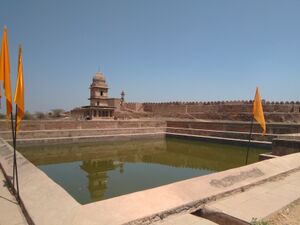
Capture of Gwalior Fort by Jats
Following the decline of the Mughal Empire, the fort was usurped by Gohad dynasty by a Jat Rana King. [11] Maharaja Bhim Singh Rana increased his power and was planning to expand his territories. He marched to Malwa in 1736 but came back and targeted the Gwalior Fort. Marathas were also in race to win the Gwalior Fort. The weak and easy-going Mughal satrap Alikhan, looking to the power of Jats, surrendered the fort to Maharaja Bhim Singh Rana. Meanwhile there was a severe fight between Marathas and Jats to win the Gwalior Fort but Jats won and the Gwalior fort came under Jats. Maharaja Bhim Singh Rana occupied the Gwalior fort from 1740-1756.[12]
In 1756 Marathas attacked the Gwalior Fort under the leadership of Mahadji Sheetole, Yammaji Rahalkar and Motiram Bani with a huge army. Maharaja Bhim Singh Rana was wounded and died in war on Chaitra sudi nawami (Ram nawami) in 1756. [13]
The Jat rulers Maharaja Bhim Singh Rana (1707–1756) and Maharaja Chhatar Singh Rana (1757–1782) occupied the Gwalior Fort thrice:
- 1740 to 1756 by Maharaja Bhim Singh Rana [14],
- 1761 to 1767 by Maharaja Chhatra Singh Rana[15], [16] [17]
- 1780 to 1783 by Maharaja Chhatra Singh Rana[18]. [19]
Historical monuments on Gwalior fort by Jats

Maharaja Bhim Singh had constructed a historical monument Bhimtal in 1754 on the Gwalior fort. His successor Maharaja Chhatra Singh Rana constructed a grand Chhatri near Bhimtal in memory of Maharaja Bhim Singh on the Gwalior Fort. Jat Samaj Kalyan Parishad Gwalior organizes a fair on Gwalior fort on Ram Navami every year in honour of Maharaja Bhim Singh Rana.[20]
Jat Samaj Kalyan Parishad Gwalior is doing important activities of Conducting research on Jat history and Jat historical places. Their greatest contribution is finding of the historical facts, never recorded in history, that Jat rulers of Gohad had occupied the Gwalior fort twice Maharaja Bhim Singh Rana (1740-1756) and Maharaja Chhatra Singh Rana (1780-1783). During this period they constructed historical monuments in the Gwalior Fort - The Chhatri of Maharaja Bhim Singh and Bhimtal.
Gwalior Stone Inscription of Mihirakula (ca. early 6th century CE)
- [Ôm!] May he (the Sun) protect you, who is victorious,-dispelling the darkness of the banks of clouds with the masses of the multitude of his rays that light up the sky; (and) decorating the top of the side of the mountain of dawn with (his) horses, which have the tossing ends of (their) manes deshevelled through the fatigue (induced) by (their) startled gait;-(and) who,-having (his) chariot-wheels (?) swallowed (?)…………. The mountain of dawn; dispelling distress; (being) the light of the house which is the world; (and) effecting the destruction of night,-creates the fresh beauty of the waterlilies by (his) rays which are of the colour of molten gold!
- (Line 2.)-(There was) a ruler of [the earth], of great merit, who was renowned by the name of the glorious Tôramâna; by whom, through (his) heroism that was specially characterised by truthfulness, the earth was governed with justice.
- (L. 3.)-Of him, the fame of whose family has risen high, the son (is) he, of unequalled prowess, the lord of the earth, who is renowned under the name of Mihirakula, (and) who, (himself) unbroken, [broke the power of] Pasupati.
- (L. 4.)-While [he], the king, the remover of distress, possessed of large and pellucid eyes, is governing the earth; in the augmenting reign, (and) in the fifteenth year, of (him) the best of kings; the month Kârttika, cool and fragrant with the perfume of the red and blue waterlilies that are caused to blossom by the smiles of the rays of the moon, having come; while the spotless moon is shining; and a very auspicious day,-heralded by the chiefs of the classes of the twice-born with the noise of the proclamation of a holy day, (and) possessed of the (proper) tithi and nakshatra and muhûrta,-having arrived;-
- (L. 5.)-The son’s son of Matritula, and the son of Mâtridâsa, by the name Mâtrichêta, an inhabitant of ………… on the hill, has caused to be made, on the delightful temple, the chief among the best of temples, of the Sun, for the purpose of increasing the religious merit of (his) parents and of himself, and of those who, by the ……… of the king, dwell on this best of mountains.
- (L. 7.)-Those who cause to be made an excellent house of the Sun, like in lustre to the rays of the moon,-their abode is in heaven, until the destruction of all things!
- (L. 7.)-(This) very famous proclamation of the true religion has been composed through devotion to the Sun, by him who is renowned by the name of Kesava and by…. ditya.
- (L. 8.)-As long as the moon shines on the thicket that is the knot of the braided hair of (the god) Sarva; and as long as the mountain Meru continues to have (its) slopes adorned by the feet of the nymphs of heaven; and as long as (the god) Vishnu bears the radiant (goddess) Srî upon (his) breast which is like a dark-blue cloud;-so long (this) chief of [stone]-temples shall stand upon the delightful summit of the hill!
- From: Fleet, John F. Corpus Inscriptionum Indicarum: Inscriptions of the Early Guptas. Vol. III. Calcutta: Government of India, Central Publications Branch, 1888, 163-164.
The Gwalior Prashasti of Gurjara-Pratihara Bhoja
[Page-99] The stone which bears this inscription was discovered in 1896, about half a mile west of Gwalior town, at Sagar Tal in the Gird-Gwalior district. It contains 17 lines. The first twelve lines are incised with great care and neatness and the letters are so distinct and beautiful that they can be read without hesitation even from a distance. The remaining lines, for some unaccountable reasons are not so distinctly engraved, but can be read, without any great difficulty, especially from the reverse side of the estampage. The whole inscription is thus clearly legible except two letters at the end of line 5 where the stone surface is damaged. The language of the inscription is Sanskrit, and except the benedictory formula at the beginning, it is throughout composed in metrical form.
[Page-100] The inscription records erection of a house in his sereglio, by the Grjar-Pratihara king Bhoja in honour of Vishnu, and begins in an invocation to that God. Verse-2 describes the creation of the Sun and names some important kings born in solar race. Verse-3 refers to Rama and his terrible fight with Ravana.The family to which Bhoja belonged is traced from Lakshamana, the younger brother of Rama (V.3).
[Page-101] Of these, Nagabhata I defeated a Mlechchha army (v. 4), and Devaraja is said to hare defeated a host of tings (v. 5). His son Vatsaraja, a famous king, forcibly wrested the empire from the Bhandi clan (vv. 6-7) and Nagabhata II defeated Chakrayudha and also conquered kings of the Anartta, Turushka, Malava, Vatsa, Matsya and other countries (vv. 8-11). Bhoja also called Mihira, is said to have defeated his powerful enemies and verses 16-26 describe his greatness in general terms.
The chronology of the kings mentioned in this inscription may be fixed with a tolerable degree of certainty. We have the dates 756-7 AD for Nagabhata I, 783-4 A.D. for Vatsaraja, 815 A.D. for Nagabhata II, and dates ranging from 843 to 881 A.D. for Bhoja. Again, we learn from a Jaina book, the Prabhavaka-charita, that king Nagavaloka of Kanyakubja, the grand-father of Bhoja died in 890 Vikrama-Samvat, and this Nagavaloka has been correctly identified with Nagabhata II. Thus the first three kings of the genealogical table may be placed between 725 and 775 A.D., and the fourth, fifth, sixth and seventh kings may be taken to have ascended the throne respectively at about 775, 800, 833 and 840 A.D.
Before the discovery of this inscription, our knowledge of the Gurjara-Pratlhra kings, who played such an important part in Indian history, was very limited and inaccurate. Although the late A. M. T. Jackson, M.A., I.C.S., and Prof. Bhandarkar laid the true foundation of our knowledge about the Gurjara-Pratlhara history, a complete understanding of the subject, in all its bearings, was impossible, in consequence of the view held by Dr, Fleet, Dr. Kielhorn and others, that the homonymous kings referred to in the copper-plates lived earlier than, and were thus different from, those mentioned in the stone inscriptions. It was the discovery of this inscription that finally settled the question and facilitated the proper treatment of the Gurjara-Pratlhara history. Dr. V. A. Smith has clearly pointed out, that the express mention of the family name of the kings in this inscription helps us to definitely assign the royal dynasty of Kanauj to the Grurjara-Pratlhira clan.
The rise and growth of the great Gurjara empire, which played such a conspicuous part in Indian polity in the ninth century AD, is clearly traced by our inscription. The names of the early kings of the dynasty, recorded in inscriptions, such as the Daulatpura copper-plate of Bhojadeva, Dighwi Dubauli plate of Mahendrapala and the Bengal Asiatic Society's copper-plate of Vinayakapala are but a mere string of names without any details such as are to be found in the present inscription. This invests our record with particular importance, and the data it furnishes may be justly said to have revealed an altogether new chapter of Indian history. The founder of the royal line is named Nagabhata, a name not yet found in any other record of the family. He is said to have defeated the Malechchha army, and the manner in which this solitary fact is mentioned with regard to him seems to show that it was looked upon
[Page-102] as of great importance in the history of the family. Now the locality of and the period when he flourished may be gathered from a passage in the Jaina Harivamsha. The passage has been noticed by various scholars, and the following remark of Dr. Fleet may be taken to represent the earlier views regarding its interpretation.
- "A passage in the Jana Harivamsha of Jinasena tells us that that work was finished in Saka-samvatvat 705 (expired)= 783-784 A.D., when there were reigning in various directions determined with town named Vardhamanapura, which has to be identified with modern Wadhwan town in the Jhalawar division of Kathiawar, in the north, Indrayudha; in the south, Shrivllabha, in the east Vatsaraja, king of Avanti (Ujjain) ; and in the west, Varaha or Jayavaraha in the territory of the Sauryas."
[Page-103]
Thus all the available evidence shows that Nagabhata I established the greatness of his family by his triumphant success over the Arabs. The Hansot plates of the Chahamana feudatory Bhartrivaddha II records a grant that was made at Broach, in the increasing reign of victory of the glorious Nagavaloka, in the year 756 A.D. Prof. D. R. Bhandarkar upheld the view that this Nagavaloka is no other than Nagabhata I, and Dr. Sten Konow has accepted it. It would then follow that he re-established the Pratihara sovereignty over Broach which the family of Jodhpur must have lost during the Arab expeditions. A reminiscence of Nagabhata's struggle with the neighbouring powers seems to have been preserved in the Ragholi plates of Jayavardhana II, a king of the Shaila dynasty, ruling over part of the Central Provinces. We are told that Prithuvardhana, a king of the family, who probably ruled about the middle of the eighth century AD, conquered the country of the Gurjaras.
We have seen above, in connection with the Jodhpur inscription of the Pratihara Bauka, how, as an indirect result of the Mlechchha invasion, the suzerainty hitherto enjoyed by the dynasty of Harichandra passed into the family of Nagabhata. It would appear that shortly after 725 A.D., when the Arab invaders seemed to have carried away everything before them and, in particular, defeated the Pratihara clan who had been ruling in Rajputana for about two centuries, Nagabhata gained successes over the Mlechchha forces and established his supremacy over the clan. The struggle which thus began between the two Pratihara families was long and tedious. Siluka, the king of the Rajputana family, succeeded in regaining his territory after defeating one Devaraja, probably the nephew of Nagabhata I. Vatsaraja, the son and successor of Devaraja, however, continued the struggle and gave the final blow to the tottering rival power. The empire over which it had ruled for well-nigh two hundred years then finally passed into the hands of the family of Nagabhata.
The data furnished by our inscription, supplemented by a few other known facts, enable us to sketch a brief history of the empire that was thus founded by Vatsaraja. Verses 6 and 7 describe his mighty prowess and splendour, and mention, in particular, that he had subdued the whole world. This statement, allowing for the natural exaggeration of the Prasasti writers, cannot be said to be altogether inaccurate, inasmuch as it is pretty certain that Vatsaraja had conquered the lord of Gauda and was thus probably master of by far the greater p&rt of Northern India. This state of prosperity, however, did not continue long. The Rashtrakuta king Dhruva inflicted a crushing defeat upon him, overran his territory as far as the Gauges
[Page-104] - NA
[Page-105] and one inscription specifically refers to the defeat inflicted upon Ngabhata by the same king, and his triumphant march to the Himalayas, It would thus appear that the Gurjara empire so laboriously rebuilt by Nagabhata II once more fell beneath the crushing blows of the hereditary foes of his family. There are reasons to believe that this was brought about by a confederacy between the two chief enemies of the Gurjaras, vis. the Palas of Bengal and the Rashtrakutas of the south. For the same inscription that records the defeat of Nagabhata II in the hands of Govinda III also mentions the fact that Dharmapala and Chakrayudha visited or submitted to the last named king of their own accord .
The victory of the Rashtrakutas, although by no means final and decisive, was no doubt disastrous to the Gurjaras. The province of Malwa passed into the hands of the Rashtrakuta, and Andhra, Vidarbha and Kalinga also possibly shared the same fate. The Pratiharas, however, did not cease to give trouble to the Rashtrakutas, for we are told in the inscription of the feudatory chief Karkaraja of Gujarat, that the Rashtrakuta king had caused his arm to become an excellent door-bar of the country of the lord of the Gurjaras.
But ere long the political situation changed. The Rashtrakutas themselves were torn asunder by internal dissensions, Karkaraja of Lata, the son and successor of Indraraja, was expelled by his younger brother in 812 A.D., and what was worse still, the revolutionary movement, thus set on foot, afterwards developed into an attempt to prevent the accession of Amoghavarsha I.
This unexpected embroglio in the Rashtrakuta affairs left the Palas and the Gurjaras free to fight among themselves. It appears that Nagabhata retained his hold upon Kanauj.
[Page-106] which he had conquered from Chakrayadha, transferred his capital there and probably succeeded in offering an effective resistance to the Palas till his death in 833-34 AD.
Of Ramabhadra, the son and successor of Nagabhata II, we know very little and Gurjara power declined during his reign is quite evident. Bhoja, the son and successor of Ramabhadra seems to have been a powerful king. Bhoja regained the Power and prestige of the family by defeating Pala kings.
Translation of Gwalior Prashasti of Gurjara-Pratihara Bhoja
- (Line L.1) Om, adoration to Vishnu !
- (Verse l.) May the dark-blue body of the Energy of (demon) Naraka protect you, that body which shines like the sky kissed by the of discs of the Sun and the Moon, inasmuch as) it is illuminated by the white lower part of the Naga Shesha used as a bed, and is made crimson by the brilliancy of the (jewel) Kaustubha glittering on its breast.
- (Verse 2.) As from the fresh seed taken from a fruit in a garden, and in a natural fertile soil, grows balbuous root of a superior kind, from which again spring forth Kalpa trees, so from the (particle of) light evolved, by the energy of demons from self-delightedness (atmarama) and sown by him in soil well qualified by nature, was born the Sun, the root of all that is good, and from the Sun, again, a line of kings such as Manu, Ikshvaku, Kaku(t)stha and the first Prithu.
- (Verse 3.) In their race, in the family in which Vishnu set foot, Rama, of auspicious birth carried on a war of destruction and slaughter with the demons – dire on account of the adamantine arrows - which killed Ravana.
- All praise unto his younger brother, Lakshamana (Saumitri),- a stern rod of chastisement in war with Meghanada, the destroyer of Indra's pride, - who served as the door-keeper (of Rama), owing to (his) commandment not to allow others to enter (lit to repel others).
- (Verse 4.) In that family, which bore the insignia of Pratihara (door-keeper), and was a shelter of three worlds, king Nagabhata I appeared as the image of the old sage (Narayana) in a strange manner, inasmuch as, having crushed the large armies of the powerful Malechchha king, the destroyer of virtue, he shone with four arms brilliant on account of the glittering terrible weapons.
- (Verse 5.) His brother's son, who added to the renown o the family and had the well-known name Kakustha (Kakutstha), but who, on account of his (habit of) saying welcome things in an inverted manner, was known, in the world as Kakkuka (i.e., one who always laughs), was a paramount king.
- (Then) was born his illustrious younger brother, Devaraja who performed the same task as the great Wielder of thunderbolt (Indra); (for) he curbed a multitude of kings (bhubhrit) by having destroyed their powerful allies (pakshah) and caused them to cast off their (free) movements (gati) ; Indra also curbed a multitude of mountains (bhubhrit) by having destroyed their powerful-wings (pakshah) and thus caused them to cast off their movements (gati).
- (Verse 6.) His son, king Vatsaraja, who was compassionate towards the entire world he had subdued, and resembled the Sun in prowess, revealed himself by attaining his own kingdom which rivaled the mountain Udaya.
- His riches, too, highly fragrant by reason of the flavour of the wine of elephant ichor, and shining in company of the needy, appeared exceedingly beautiful, having eclipsed the lotus-eyed women, who too became exceedingly merry by having tasted wine which was like ichor of elephants and appeared charming in the fond embrace of their lovers.
- (Verse 7.) With strong bows as his companion he forcibly wrested the empire, in battle from the famous Bhandi clan, hard to be overcome by reason of the rampart made of infuriated elephants.
- Having successfully wielded a position weighty with renown, he, the foremost among the most distinguished Kshatriyas, stamped the noble race of Ikshvaku with his own name by virtue of his blameless conduct.
- (Verse 8.) The primeval man was again born to him, and, being far-famed, and possessed of elephant hosts, was called Nagabhata (II).
- The kings of Andhra, Sindhu, Vidarbha and Kalinga succumbed to his youthful energy as moths do unto fire.
- (Verse 9.) Who, desirous of the great growth of -virtuous acts enjoined in. the Vedas, performed a series of religious ceremonies according to the custom of the Kshatriya families ; and, after having defeated Chakrayudha, whose lowly demeanour was manifest from his dependence on others, he became eminent, although he (life his body) was humble through modesty.
- (Verse 10.) Having vanquished his enemy, the lord of Vanga, who appeared like a mass of dark-dense cloud in consequence of the crowd of mighty elephants, horses and chariots, Nagabhata, who alone gladdens (the heart of) the three worlds, revealed himself, even as the rising Sun, 'the sole source of manifestation of the three worlds, reveals himself by vanquishing dense and terrible darkness.
- (Verse 11.) Of him, whose mode of life was beneficial to all mankind, the incomprehensible royal qualities (like eloquence, statesmanship, etc,) became manifest in the world, even from boyhood, by his forcible seizure of the hill forts of the kings of Anartta, Malava, Kirata, Turashka, Vatsa and Matsya.
- (Verse 12.) (The great Rama), the protector of virtue, after having forcibly bridged over the oceans (lit. the lords of rivers), full of exceedingly cruel animate, by means of continuous chain of rocks placed by the best monkey force, looked bright by having killed the evil-doers who served as obstacles and (as he thereby) got (lit. was joined by) his wife and renown. His (Nagabhata's) son, Rama by name, also shone fort like tide (homonymous) predecessor, by similar worthy deeds ; for he, the defender of religion, too, had the haughty and cruel commanders of armies forcibly bound down by (his subordinate) kings who had the best cavalry under their charge, and looked radiant by having , destroyed the obstacles caused by the evil doers (as he thus) attained the fame which was unto him even as a consort.
- (Verse 13.) That lord of prosperity, who had overpowered the points of compass by means of valour (alone), unsupported by the other expedients (such as sama, dama, bheda), was yet demurely waited upon by the other Means (i.e. although he neglected them as necessary, they were within his beck and call).
- (Verse 14) The production of the wealth of that successful one was merely a source of delight ; it was at the disposal of the supplicants, but never a to satisfy his own desires,
- (Verse 15.) A pure soul, averse from the world, he obtained a son, by name Mihira, by (the favour of) the Sun, propitiated by mysterious rites, in order to dispose of the lordship over his subjects.
- (Verse 16.) The lord, who ruled over many kings (bhubhrit) after having overcome them, and (being therefore) known as Bhoja, shone more gloriously than Agastya who (merely) checked the rise of (a single bhubhrit, i.e. mountain) Vindhya through favour (and not by his own prowess).
- (Verse 17.) Famous, unperturbed, adept in removing the evils of the world, embraced by Lakshmi (sovereign power), but not soiled by the stain of arrogance, he was affectionate towards the meritorious and an asylum of good and pleasant words. Does he or Rama stand foremost when Brahma counts his own creation ?
- (Verse 18.) The other Lakshmi, the source of the of fame of Dharmma’s (Dharmapala’s) son, who was cast out of the ocean of hostile forces, churned by the Kula mountains in the form of kings of his (Bhoja's) own race, who was married by offering (as an oblation) fried grains, which were the destroyed enemies in the fire of his valour, and who was protected by (his), superior accomplishments, mild, uncommon and pure like nectar, became a fit remarried bride of that king.
- (Verse 19.) In order to extend the duration, of his life beyond all measure, the, ascetics on account of the protection afforded to them, the preceptors out of affection, the servants out of devotion, the multitude of foes, out of policy, and mankind in general, for the sake of its livelihood, made their respective services (treasures) subservient to him, who was worthy a recipient as the Creator Himself.
- (Verse 20.) According to the injunction of the Sruti, this is a truism, so long as the world lasts, that he who does a thing enjoys the fruits thereof, and not (another) though he be the lord of even hundred kings. It is strange that the meritorious deeds of honest men, whose intellect was undefiled, went to increase the prosperity of this king, who was the conqueror of Kali and the Lord of fame.
- (Verse 21.) Of him, who had burnt the powerful hostile races by the fire of his anger, and guarded the oceans by his valour, the absence of greed (for further conquest) shone indeed (even as the satiety of a man who had drunk a large quantity of water).
- (Verse 22.) Like Kumara (Karttikeya) with his host of Matrika who performed wonderful deeds, he subdued the terrible Asuras with the help of a band of woman that lived upon arms.
- (Verse 23.) Vidhi (Fate), writing anew (the destinies of the world), wrote in the chancery of that king, looking at (i.e. being guided by) his face, since the latter was the master of the world in consequence of his prowess. (In other words the destiny of the world was absolutely at the command of that all-powerful king.)
- (Verse 24.) Fame, resulting from the unbounded energy of that lord of the world, was unto him even as a consort, and like a flame, issuing out of a flood of luxuriant lustre, returned after conquering the Sun. It is a wonder that she crossed the oceans.
- (Verse 25.) In order to increase the fame and religious merit of his consorts, the king erected a house within his seraglio compound in the name of Narakadvisha (Vishnu).
- (Verse 26.) As long as the sky has the flowing celestial stream (Ganga) as it upper garment, as long as there lasts the power originating from severe religious austerities, as long the truth protects all that is above, so long may this noble and famous work purify the world.
- (Versa 27.) Baladitya (is) the poet of this prasasti which would exist along with the world up to the end of the Kapa; (he,) the son of Bhattadhaneka and the fruit of penances, as it were of a number of learned men, (is) the (personified) inner facility of discrimination, standing before king Bhojadeva, the protector of the, world, inasmuch m he (Baladitya) follows the good rules sanctioned by the best of sages.
Gwalior Inscription of 876 CE
The first inscription showing the use of zero which is dated and is not disputed by any historian is the stone inscription found at the Chaturbhuja Temple at Gwalior dated 933 in the Vikrama calendar (876 CE.), where 50 garlands are mentioned (line 20), here 50 and 270 are written with zero.[21]
Gwalior Fort Inscription of 1453 CE
| सं १५१० वर्षे माघ सुदी ८ सोमे गोपाचल दुर्गे तोमर वंशान्वये राजा श्री डूंगरेन्द्र देव राज्य पवित्रमाने श्री काष्ठासंघ माथुरान्वये भट्टारक श्री गुणकीर्ति देवास्तत्पट्टे श्री मलयकीर्ति देवास्ततो भट्टारक गुणभद्रदेव पंडितवर्य रइघू तदाम्नाये अग्रोतवंशे वासिलगोत्रे सकेलहा भार्या निवारी तयोः पुत्र विजयष्ट शाह ... साधु श्री माल्हा पुत्र संघातिपति देउताय पुत्र संघातिपति करमसीह श्री चन्द्रप्रभु जिनबिंब महाकाय प्रतिष्ठापित प्रणमति ..शुभम् भवतु ..|| |
| A Gwalior Fort Inscription 1453 CE[22] |
In the early 15th century, Agrawals flourished as a trader community, under the Tomaras of Gwalior.[23] According to several Sanskrit inscription at the Gwalior Fort in Gwalior District, several traders (Sanghavi Kamala Simha, Khela Brahmachari, Sandhadhip Namadas etc.) belonging to Agrotavansha (Agrawal clan) supported the sculptures and carving of idols at the place.,[24][25] Historian K.C. Jain comments:
- "Golden Age of the Jain Digambar Church in Gwalior under the Tomara rulers inspired by the Kashtha Bhattarakas and their Jaina Agrawal disciples who dominated the Court of father and son viz. Dungar Singh (1425-59)and Kirti Singh (1459-80) with the Poet-Laureate Raighu as their mouthpiece and spokesman, a centenarian author of as many as thirty books, big and small of which two dozen are reported to be extant today. Verify the advent of the Hisar-Firuza-based Jain Agrawals who functioned as the ministers and treasurers of the ruling family had turned the Rajput State of Gwalior into a Digambara Jain Centre par excellence representing the culture of the Agrawal multi-millionner shravakas as sponsored by them."
Gujari Mahal
दिनांक 18 अप्रैल 2022 को वर्ल्ड हेरिटेज डे पर इंदरगढ़ का किला जिला दतिया को राज्य संरक्षित स्मारक घोषित किया गया है । इस उपलक्ष और विरोध स्वरूप ज्ञापन कि ग्वालियर किले पर पुरातत्व विभाग भीम सिंह राणा छतरी प्रांगण में एक टूरिस्ट होटल बनाने की योजना है, देने जाट समाज कल्याण परिषद् क्यूरेटर कार्यालय गुजरी महल ग्वालियर गए। जाट समाज कल्याण परिषद् द्वारा ज्ञापन देने के साथ ही गुजरी महल पुरातत्व विभाग ग्वालियर से कुछ प्राप्त अभिलेख और वहाँ संग्रहित दुर्लभ मूर्तियों के चित्र यहाँ दिये जा रहे हैं।
Pin codes of villages in Gwalior district
• Antri 475001 • Behat 475002 • Bhander 475335 • Bhitarwar 475220 • Collectorate Gwr 474001 • Dabra 475110 • Dabra Jwalaganj 475110 • Dabra Tehsil 475110 • Darpan Colony 474005 • Daulatganj 474001 • Gwalier Utila 474055 • Gwalior (laskhar) H O 474001 • Gwalior Birlanagar 474004 • Gwalior City 474003 • Gwalior Fort 474008 • Gwalior Jaderukalan 474040 • Gwalior Laskhar City 474009 • Gwalior Maharajpur A F 474020 • Gwalior Morar H O 474006 • Gwalior Motijheel 474010 • Gwalior Motimahal 474007 • Gwalior Panihar 474042 • Gwalior R S 474002 • Gwalior Residency 474005 • Hazira Chauk 474003 • J A Hospital 474009 • Jacob Parade 474001 • Janakganj 474001 • Jiwaji University 474002 • Jiwajiganj 474001 • K P Colony 474002 • Kampoo 474001 • Lala Ka Bazar 474001 • Lashkar H O (gwalior) 474001 • Laxmiganj 474001 • Madhoganj 474001 • Morar H O (gwalior) 474006 • Morar Military Camp 474006 • Morar Town 474006 • Naya Bazar 474009 • Naya Sarafa 474001 • Panihar (gwalior) 474042 • Phalka Bazar 474001 • R B Colony 474002 • R K Puri 474006 • S K Chhaoni 474009 • Salon B 475336 • Shaktingar 474002 • Sikandar Kampoo 474001 • Tekanpur (gwalior) 475005 • Tilaknagar 474001 • Usha Colony 474009 • V N Marg 474001 • Airaya 475001 • Ajaypur 474001 • Akbai 475005 • Amrol 475001 • Aron 475330 • Badera Bujurg 475115 • Badori 475001 • Bagwai 475220 • Bandholi 474006 • Barki Sarai 475001 • Beru 475005 • Bhadroli 474010 • Bhageh 475115 • Bhangna 475110 • Bhensnari 475110 • Bhori 475001 • Bijoli 474006 • Bilhati Kalan 474006 • Billowa 475001 • Birla Nagar 474004 • Chandpur 475110 • Chhimak 475110 • Chinore 475110 • Chirpura 475001 • Collectorate 474001 • Dabka 475002 • Dabra Gaon 475110 • Dabra Lsg 475110 • Darpan Colony Gwalior 474011 • Defence Colony 474002 • Dharamshala [d.d. Nagar] 474020 • Dhuan 475330 • Dorar 475330 • Dubha 475220 • Gadajar 475220 • Gharsondi 475110 • Ghatigaon 475330 • Gijjora 475115 • Girgaon 474020 • Gohinda 475220 • Gwalior R.s. 474002 • Harsi 475220 • Hastinapur 475002 • Hathnora 475115 • Hazira Chowk 474003 • Industrial Estate Gwalior 474002 • Itm 474001 • Itma 475220 • J.a. Hospital 474009 • Jaderuakalan 474006 • Jakhara 475002 • Jakhoda 475330 • Jamahar 474010 • Janak Ganj 474001 • Janaktal 474001 • Jhadoli 475220 • Jigsoli 474010 • Jiwaji Ganj 474001 • Jorasi 475001 • K.p. Colony 474002 • Kachhaua 475001 • Kalyani 475005 • Karahi 475330 • Karahiya 475220 • Kariyawati 475220 • Kerua 475220 • Kethoda 475115 • Khediraimal 475110 • Kitora 475115 • Ladhera 475001 • Ladhwaya 475005 • Lashkar City 474009 • Lashkar H.o. 474001 • Laxmiganj Mandi 474010 • Maharajpura 475110 • Maharajpura A.f. 474020 • Mastura 475220 • Mauchh 475001 • Mehgaon 475110 • Mena 475110 • Mohan Garh 475220 • Mohna 475330 • Morar H.o. 474006 • Moti Jheel 474010 • Moti Mahal 474007 • Mudia Pahad 474001 • New High Court 474011 • Odhpura 474010 • Panihar 475330 • Par 475001 • Parsen 474006 • Patai 475330 • Pichhore Gird 475115 • Purani Chhawani 474010 • Putti 475115 • R.b. Colony Gwalior 474002 • R.k Puri Gwalior 474011 • Rahi 475220 • Rangawan 475002 • Ratwai 474006 • Renhat 475330 • Richharikalan 475220 • S.p. Ashram 474012 • Sabrai 475330 • Salwai 475110 • Samaya 475110 • Sankhini 475220 • Senthri 474020 • Shakti Nagar 474002 • Shankarpur 474010 • Shinde Ki Chhawani 474001 • Shukalhari 475115 • Sigora 474010 • Simaria Tal 475110 • Simariatanka 475330 • Singharan 475220 • Sirsod 474006 • Sukhapatha 475115 • Supaoli 474006 • Susera 474010 • Tankoli 475002 • Tekanpur 475005 • Tighra 474001 • Tiholi 475002 • Tilak Nagar 474001 • Ummegarh 475330 • Urba 475001 • Utila 474006 • V.n. Marg 474001 • Wahangikhurd 474006
List of Villages in Gwalior District
Ajaigarh, Akbai, Akbai Badi, Amroul, Antari, Aroli, Aron, Arru, Badagaon, Badagaonjagir, Baderafutkar, Badki, Bagwai, Bahadurpur, Bahangikhurd, Bajna, Bandholi, Baniya Tor, Banwar, Barahana, Barai, Baraua Nurabad, Baretha, Barol, Barotha, Basondi, Behat, Behata, Benheri, Beragarh, Berja, Bhageh, Bharthari, Bhengana, Bhensnari, Bhitarwar, Bhori, Bijak Pur, Bijoli, Bilara, Bilaua, Bilheti, Buzurg, Chait, Chak Keshopur, Chand Pur, Chaproli, Charkha, Chhimak, Chinour, Chiruli, Chitawani, Chitoli, Dabka, Dabra, Dangiyapura, Daulatpur, Deogarh, Deogarh, Deori Kalan, Dhahi, Dhiroti, Doni, Dorar, Dubaha Tanka, Dubahi, Dugnawali, Duhiya, Eraya, Fusawali, Gadajar, Gadhi, Gadhota, Gharsondi, Ghatigaon, Gijaurra, Gohinda, Gundhara, Gurri, Guthina, Gwalior, Harsi, Hastanapur, Hathnoura, Himmatgarh, Hukamgarh, Ikehara, Ikona, Itayal, Itma, Jakhara, Jakhoda, Jamroha, Jarga, Jatrathi, Jaura, Jhadoli, Jigsoli, Jorasi, Kachhaua, Kaitha, Kaithi, Kaithoda, Kalyani, Karahi, Karahi, Karhiya, Kariyawati, Kerua, Khadwai, Khairwaya, Kheda Bhitarwar, Kheda Tanka, Khedi Raimal, Khureri, Kiroi, Kishorgarh, Kithoda, Kitora, Kuleth, Kumharra, Ladera, Lakhan Pura, Lakhnoti, Lidhora, Lidhoura, Lohgarh, Ludhari, Magrora, Maharaj Pur, Maina, Malnpur, Mastura, Masud Pur, Mehadpur, Mehagaon, Mehgaon, Milawali, Mohana, Mohangarh, Mohnpur, Morar Cantt, Mukhtyarpur, Naugaon, Nayagaon, Nibi, Nirawali, Odpura, Pachora, Palayachha, Pali Dirman, Panihar, Par, Parsen, Patai, Patha Panihar, Pawaya, Pichhore, Pipraua, Putti, Rahi, Raipur, Rairu, Rangawan, Rarua, Ratwai, Renhat, Richhari Kalan, Richhari Khurd, Rithondan, Rora, Saharan, Sahasari, Sahona, Salwai, Samaya, Samrai, Samudan, San Khini, Sarnagat, Sekrajagir, Semari, Shuklhori, Shyampur, Sigora, Simiriya Tal, Simiriya Tanka, Singpur, Sinharan, Sirohi, Siroli, Sirsa, Sirsa, Sirsaud, Sisgaon, Sojna, Soni, Sonsa, Sukha Patha, Supawali, Susera, Syau, Tekanpur, Tighra, Tiholi, Udaipur, Ummedgarh, Urwa, Utila, Virampura,
Notable persons
- Dilip Singh Rana - 90/2 Tokonya Murar, Mob: 9425118211
- Ramvir Singh - F-13, Dr Rajendra Prasad Colony, Tansen Marg, Gwalior – 474002, Phones: 0751-2382130, Mob:8989415641
- ठाकुर मुंशीलाल - [पृ.572]: आप जिला मेरठ के चौधरी बलवंतसिंह जी के सुपुत्र हैं। जन्म आपका संवत 1969 विक्रमी में हुआ है। गोत्र आपका कुंडू है। आप दो भाई हैं। छोटे भाई का नाम खेमसिंह है। आप इधर न्यू वर्ष से ग्वालियर में रहते हैं। इस समय आपकी ट्रक (मोटर ठेला) सर्विस चलती है। आपने इधर आर्य समाज के सिद्धांतों का प्रचार करने में काफी कोशिश बिड़ला मिल की कॉलोनी में की है। साथ ही यहां जाटों में समाज सुधार की प्रेरणा की है। मिल के अंदर भी जाट सभा कायम हुई है इसके आप मंत्री रहे। ग्वालियर के प्रवासी जाटों में आपने जाट साहित्य का प्रचार और प्रसार किया। आप एक उत्साह और शांत प्रकृति के व्यक्ति हैं और कौम से हार्दिक प्रेम रखते हैं। [26]
- Chandra Pal Singh Sirohi
- Prem Singh Aryavir (born:05.01.1939-death:06.08.2021) was a key figure in taking Jat Samaj Kalyan Parishad Gwalior to great heights where his efforts were acknowledged at national level. As president of Jat Samaj Kalyan Parishad, Gwalior he was instrumental in making of Jat Dharmanshala at Gwalior, conducting annual Akhil Bhartiya Kisan Rana Mela at Gwalior fort in the memory of Maharaja Bhim Singh Rana. Kisan Mela at Gwalior was attended by many dignitaries from across India and brought special recognition to endeavours of Jat samaj Gwalior at National level. Originally from village Khanpur Khitauli of Uttar Pradesh, he settled in Gwalior.
- Mohan Singh Rawat (01.03.1930-08.09.2022) or Mohan Singh Arya was a social worker from Gwalior Madhya Pradesh. He was born at village Beesalpur in Kheragarh tahsil of Agra district in Uttar Pradesh.
- Shivendra Singh Nauhwar is coach of Air India Hockey team. He is from Tansen Marg, Gwalior, Madhya Pradesh.
Gallery
Chattri of Maharaja Bhim Singh Rana at Bhimtal, Gwalior. Place:- Gwalior Fort, Source - [https://www.facebook.com/JatKshatriyaCulture/photos/a.362623241108482/427936654577140 Jat Kshatriya Culture
External links
See also
References
- ↑ Falling Rain Genomics, Inc - Gwalior
- ↑ History of the Jats/Chapter IV ,p. 58
- ↑ Ram Sarup Joon: History of the Jats/ChapterVIII,p. 138
- ↑ Ram Sarup Joon: History of the Jats/ChapterVIII,p. 139
- ↑ Aitihasik Sthanavali by Vijayendra Kumar Mathur, p.300
- ↑ Aitihasik Sthanavali by Vijayendra Kumar Mathur, p.281-284
- ↑ Thakur Deshraj:Jat Jan Sewak, 1949, p.560-562
- ↑ ततॊ गॊपाल कच्छं च सॊत्तमान अपि चॊत्तरान, मल्लानाम अधिपं चैव पार्दिवं वयजयत प्रभुः (II.27.3)
- ↑ कच्छा गॊपाल कच्छाश च लाङ्गलाः परवल्लकाः, किराता बर्बराः सिद्धा विदेहास ताम्रलिङ्गकाः (VI.10.55)
- ↑ Kings of Kashmira Vol 2 (Rajatarangini of Kalhana)/Book VIII, p.94-95
- ↑ Thorton p. 68-69
- ↑ Dr Natthan Singh (2004) : Jat-Itihas, Jat Samaj Kalyan Parishad, Gwalior,p.359
- ↑ Dr Natthan Singh (2004) : Jat-Itihas, Jat Samaj Kalyan Parishad, Gwalior,p.359
- ↑ Dr Natthan Singh (2004) : Jat-Itihas, p. 359
- ↑ An Historical Sketch of the Native States of India’, by Col. G B Malleson. Facsimile reprint published by The Acadamic Press, Gurgaon, 1984.
- ↑ V.S.Krishnan:Madhya Pradesh District Gazetteer, Gwalior
- ↑ ‘Gohad ke jaton ka Itihas’, Dr. Ajay Kumar Agnihotri, Nav Sahitya Bhawan. (New Delhi, Delhi. 1985), p. 29
- ↑ Dr Natthan Singh (2004) : Jat-Itihas, p. 360
- ↑ An historical sketch of the native states of India/Gwalior, by Col. Malleson, p. 143
- ↑ Dr Natthan Singh (2004) : Jat-Itihas, Jat Samaj Kalyan Parishad, Gwalior,p.360
- ↑ The Hindu-Arabic Numerals By David Eugene Smith, Louis Charles Karpinski
- ↑ http://www.webdunia.com/dharm/jain/gopachal/19_gopachal9.htm Gopachal ke Jinamandir
- ↑ Kashtha Sangha Bhattarakas of Gwalior and Agrawal Shravakas, Dr. K. C. Jain
- ↑ [http://www.webdunia.com/dharm/jain/gopachal/19_gopachal9.htm गोपाचल के जिन मन्दिर एवं प्रतिमाएँ
- ↑ रामजीत जैन, गोपाचल सिद्ध क्षेत्र, १९८७
- ↑ Thakur Deshraj:Jat Jan Sewak, 1949, p.572
Back to Jat Monuments/Madhya Pradesh
- Jat Monuments
- Madhya Pradesh Districts
- Jat Villages in Madhya Pradesh
- Villages in Gwalior
- Inscriptions
- Inscriptions in Madhya Pradesh
- Parihar History
- Jat Forts
- Jat Forts in Madhya Pradesh
- Jat Forts in Gwalior
- General History
- AS
- AS MP
- Mahabharata People
- Mahabharata Places
- Mahabharata People and Places
- Jat History
- Rajput History
